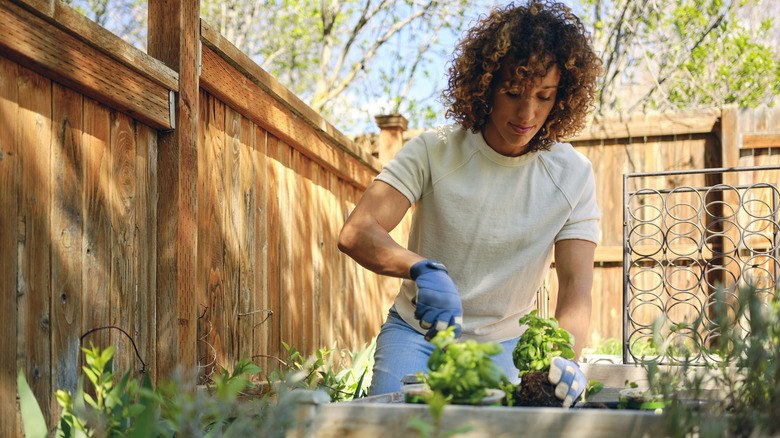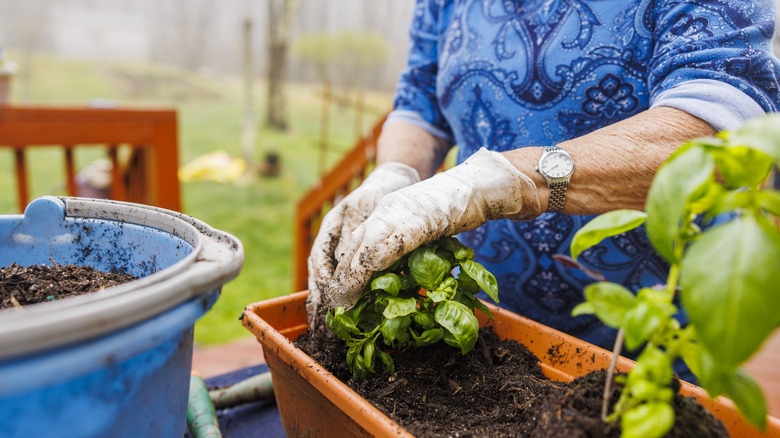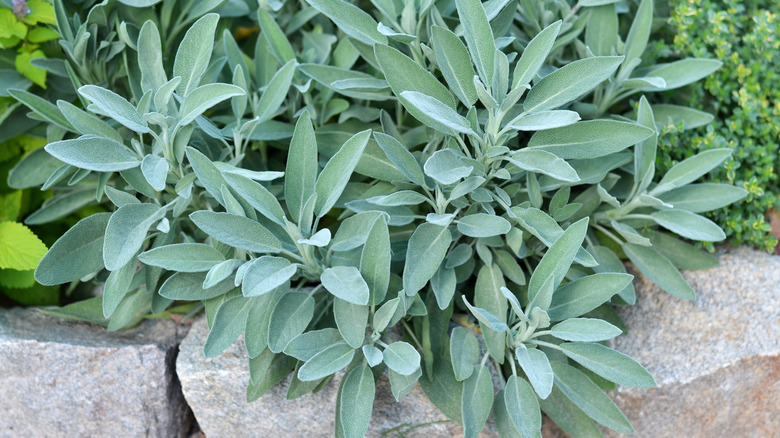The Two Popular Herbs That Don't Thrive Together In The Garden
Growing your own herbs is a classic summer hobby that rewards you with fresh aromatics and delicious culinary adventures. What's great about this pastime is that, while herbs thrive outdoors in the summer, they're also small enough to manage in modest containers throughout the year, even during the colder months. If you are tight on space without access to a yard or a balcony, herbs are perfectly happy to bask in the sun on a windowsill. Typically, herbs are low-maintenance plants that you can choose to grow from seed. Alternatively, you can skip the germination process and pick up already-started seedlings at your local nursery or hardware store. Nevertheless, if you'd like to embark on harvesting your own herbs, it's important to know that while they are low maintenance, how much care and what type of care you provide varies by plant. For this reason, you should keep your basil and your sage in separate containers.
Growing your herbs in one container can be tempting, as it's convenient and provides an Instagrammable aesthetic. Doing so, though, may not result in flourishing plants, as basil and sage have different care preferences. Basil enjoys warm, moist conditions with lots of sunlight throughout the day in order to produce bountiful and large leaves. On the other hand, sage prefers drier soil and more moderate temperatures. Planting the two together will inevitably result in sacrificing the needs of one plant for the other, so it's best to plant them separately.
How to care for your basil
Basil may be one of the most popular herbs to add to your herb garden or grow inside due to its appearance in a number of cuisines, and the ease of growing it. Every time you snip a few leaves from basil, it produces new shoots, producing even more leaves for your next harvest. It's an excellent windowsill warrior and can also be grown more widely in your garden, too. Wherever you choose to plant it, you'll enjoy its sweet, herbaceous scent.
When growing your own basil, it's important to use well-draining soil and to choose a warm, sunny location. Basil thrives with lots of sun and consistently moist soil. Do be sure its container has good drainage holes though so the roots don't become waterlogged with its frequent waterings. To encourage your basil to grow into a full bush, prune it regularly, pinching off the top set of leaves. Also, be sure to remove any flowering tops to preserve its rich flavor and to prevent it from dying off.
If you'd like to plant basil with a container companion, there are a number of great alternatives to sage that will enjoy the same growing conditions as basil. Some complementary herbs are parsley and chives. Not only will these options look great together, but they also pair well in flavor profile. All three enjoy lots of sun with consistently hydrated, well-draining soil. Plant them together for harmonious and tasty results.
How to care for your sage
Though providing a vastly different flavor profile than basil, sage is also a highly aromatic herb that is popular in autumn dishes and is often used for other aromatic benefits and even cultural rituals. Like basil, sage enjoys well draining soil, but it does prefer to dry out in between waterings. To help prevent root rot, be sure its container has good drainage holes and choose potting soil with extra sand or perlite to help improve the drainage. Place sage on a sunny windowsill or in a bright spot in your garden. Then allow the top inch or so of the soil to dry out before watering it again, as it does not enjoy the same level of moisture as basil.
Companion planting can benefit your garden if you choose to pair sage with other herbs or plants that have similar care needs. Some complementary herbs that room well with sage are rosemary, thyme, and oregano. Not only will these other herbs provide excellent aromatics and flavors, but they all look quite different, adding to a visually appealing aesthetic. Each of these plants also thrives in similar conditions with well-draining soil and sunny locations. Like with sage, you can allow the soil to dry out in between waterings, as they are all drought-tolerant species that do not enjoy consistently damp soil. Feel free to plant them together in one container or near one another in your garden beds.



